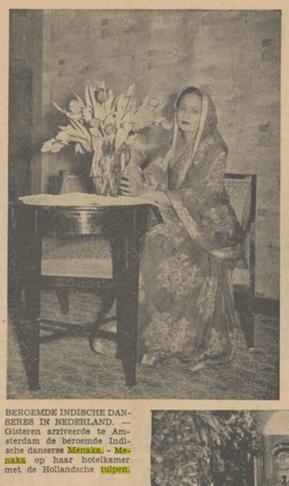
When Flowers speak
It is February 1936. Nevertheless, a bouquet of fresh tulips decorates the table of an hotel room in Amsterdam, where the Indian dancer Menaka has just arrived. Tulips can be forced into premature blooming by chilling. Amsterdam residents can therefore greet their illustrious guest with an atmosphere of spring blossom, while in Finland the preparations for Olympic Winter Games in Garmisch-Partenkirchen are taking place. The photographer has prominently draped the tulip bouquet in front of the „famous Indian dancer Menaka“, possibly to underline the analogy of the colors of her saree and the Dutch national flowers. The result is a somewhat bizarre composition, in which the bouquet of tulips and the Indian diva in her magnificently embroidered saree wrestle for the viewer’s favor.
It seems as if the grammar of flower language had courageously guided the editors of the Twentsch dagblad in the layout of the illustrated page.
Directly below the figure of Menaka, a Nazi committee can be seen transferring the coffin of the Swiss NSDAP group leader Wilhelm Gustloff to Germany. Gustloff was shot on February 4, 1936 in his apartment in Davos by the Jewish student David Frankfurter. The Nazis also let flowers speak. Gustloff’s coffin is covered all over with funeral wreaths. These in turn are reminiscent of another floral motif in which the history of international dance and the political history of those years are interwoven. In December 1939, the Reichsdeutsche Community in the Netherlands proudly reported to Goebbels‘ Ministry of Propaganda about a propaganda success following a performance by the German dancer Harald Kreutzberg in Amsterdam: „It is particularly noteworthy that one of the three donations of flowers for Kreutzberg was a flower arrangement from the colony, of which the ribbon with the swastika stood out very clearly when placed on the stage. This most unobtrusive and yet remarkable emphasis on the German character of this evening is likely to have been accepted and noted by all visitors (except the numerous Jews). A very successful propaganda!“
Sources:
Lilian Karina und Marion Kant, Tanz unterm Hakenkreuz: eine Dokumentation, 2., erg. Aufl (Berlin: Henschel, 1999).